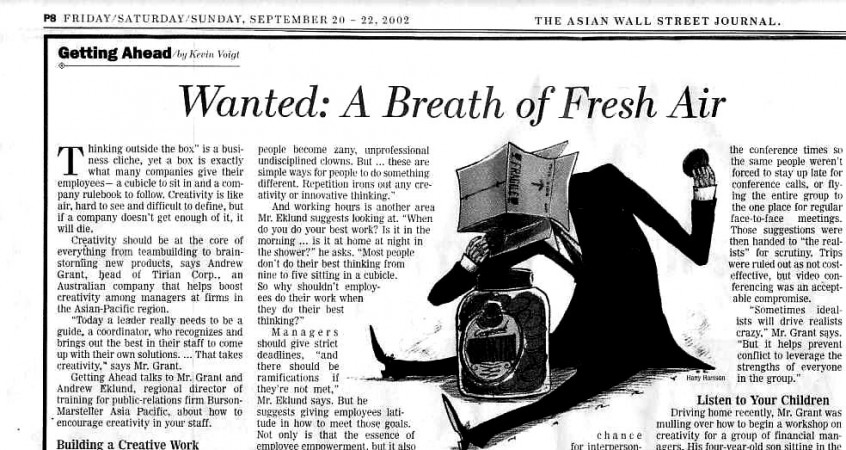How to Morph Into a More Creative Manager (Asian Wall Street Journal)
By Kevin Voigt of The Asian Wall Street Journal
“Thinking outside the box” is a business cliche, yet a box is exactly what many companies give their employees — a cubicle to sit in and a company rulebook to follow. Creativity is like air, hard to see and difficult to define, but if a company doesn’t get enough of it, it will die.
Creativity should be at the core of everything from teambuilding to brainstorming new products, says Andrew Grant, head of Tirian Corp., an Australian company that helps boost creativity among managers at firms in the Asian-Pacific region.
“Today a leader really needs to be a guide, a coordinator, who recognizes and brings out the best in their staff to come up with their own solutions. . . . That takes creativity,” says Mr. Grant.
Getting Ahead talks to Mr. Grant and Andrew Eklund, regional director of training for public-relations firm Burson-Marsteller Asia Pacific, about how to encourage creativity in your staff.
Building a Creative Work Environment
The popularity of corporate creativity programs rose and fell with the information-technology bubble, but Mr. Eklund says creativity needs to be nurtured even more during tough times. “I’m not saying you need a musician on staff. You’re not necessarily looking for that kind of creativity,” says Mr. Eklund, who leads creativity workshops for Burson-Marsteller employees and clients world-wide. “But if you keep doing things the same way, don’t expect to get different results.”
Diversity Increases Creativity
At a recent workshop with Burson-Marsteller staff in Hong Kong, Mr. Eklund gave employees a 48-question survey to judge their different learning styles. Their answers divided them into four categories: “activists” — more creative and experimental; “reflectors” — people who need to think things through; “pragmatists” — those who see practical applications; or “theorists” — people who require rules and a well-defined process to reach a decision.
The survey results illustrate a common problem: Managers tend to unconsciously surround themselves with people like them. While that might reduce the chance for interpersonal problems, there’s little chance that a team made up of the same type of people is going to come up with original ideas. “Acknowledge that people think differently than you do . . . and that’s a good thing,” Mr. Eklund says.
Mr. Grant, of Tirian, was hired by a U.S. multinational IT company to help spur its creativity. He devised a “walk around” system for the company. Problems that were the subject of discussion were broken down and handed to different employees with different strengths. Executives complained, for example, that the company’s “virtual teams” — work groups across 10 time zones who met only by teleconference — were having difficulties working together. To combat the problem, the “idealists” in the group of executives were asked to brainstorm solutions. They came up with ideas such as rotating the conference times so the same people weren’t forced to stay up late for conference calls, or flying the entire group to the one place for regular face-to-face meetings. Those suggestions were then handed to “the realists” for scrutiny. Trips were ruled out as not cost-effective, but video conferencing was an acceptable compromise.
“Sometimes idealists will drive realists crazy,” Mr. Grant says. “But it helps prevent conflict to leverage the strengths of everyone in the group.”
Listen to Your Children
Driving home recently, Mr. Grant was mulling over how to begin a workshop on creativity for a group of financial managers. His four-year-old son sitting in the front seat next to him bit into a cookie. “Look, it looks like a boat,” his son said. Next bite: “Now it looks like a mountain.” Crunch: “Now it’s a car.” The next morning, 30 financial managers were biting into cookies and describing what they were seeing.
The message is this: At 45, you may have a lot of experience, but at five years old, you had a killer imagination. Get those two people to meet, and good ideas will flow, Mr. Grant says. Twelve years of “rote education” in Asian schools does little to exercise creative minds, Mr. Grant says.
Want to improve your creativity? “Then spend 30 minutes each day playing with your kid,” Mr. Grant says. “Look at the world through their eyes.” Or read a good book. Or draw. “Do anything that takes your mind in a different direction than what you’ve been doing all day.”
by Kevin Voigt: Asian Wall Street Journal (used with permission)



